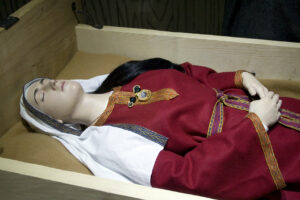Indications of early settlement have been found on Swallowcliffe Down, which suggest habitation dating back to Mesolithic times. There is evidence of an Iron Age farmstead where the boundaries of Ansty, Swallowcliffe and Alvediston now meet, as well as storage pits suggesting the presence of farmers and weavers.[ii] The Swallowcliffe Princess may have presided over this area in her own right, with the location of her burial suggesting a greater connection to the local area and landscape, than that of a traveller to the area.
The name Swallowclifee means ‘swallow cliff or slope’ and has been known since the Saxon times as ‘The Cliff of the Swallow,’ a local joke. It was first recorded in AD940, when King Edmund established a Charter for the land. The Swallowcliffe borders with Alvediston, Ebbesbourne Wake, Tisbury, Wardour, and Sutton Mandeville, have changed little since 940.[iii]
The Domesday book completed in 1086, indicates that there were seven households in the area, and 8.5 hides of land that were taxed. Swallowcliffe was divided into three parts. The first held by Wilton Abbey included one unfree tenant and two smallholders, two ploughlands and two acres of meadow. The second was owned by Alward and comprised two unfree tenants and 1.5 ploughlands and the third was owned by Brictric and comprised two unfree tenants and one ploughland; the total value was just under £5 and the population was approximately 40 – 60 people at this time.


